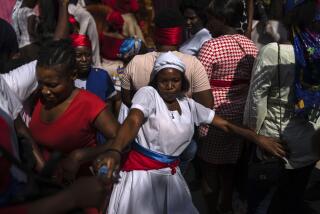Religion Is Big Business at the Shrine of Lourdes
- Share via
LOURDES, France — Images of the Virgin Mary still dominate Lourdes more than a hundred years after a teen-age peasant girl said she had seen visions of the mother of Christ in this southern French town.
Images in porcelain, images in plastic.
Religion is big business at France’s most sacred shrine.
In the streets around the small grotto where Bernadette Soubirous said she saw Mary, brightly-lit signs entice visitors into the souvenir shops.
Inside, the Virgin’s image adorns objects ranging from cigarette lighters to screw-top bottles for Lourdes’ famous “healing” water.
There are statues of Mary for every room in the house, with outdoor models for the garden.
On the main street, up from the grotto, a multilingual tape exhorts passers-by to “come in and discover the waxwork museum, the life of Bernadette Soubirous and the life of Jesus Christ.”
Bernadette, a 14-year-old shepherdess, said she had 18 visions of the Virgin Mary between February and July, 1858.
Long before she was made a saint 75 years later, religion had become Lourdes’ No. 1 source of income.
The streets around the grotto were built in the 1870s, only 15 years after the visions.
“I was deeply struck by the two sides of Lourdes, the religious and the commercial,” said Jule Waku, a young pilgrim from the Cameroon. “What bothers me is that the shops are even open on Sundays and the big religious festivals.”
Waku was one of 60,000 pilgrims in Lourdes for August’s annual national pilgrimage, when Roman Catholics visit the town to celebrate the Virgin’s assumption into heaven.
But while businesses across the rest of France shut for the Aug. 15 Assumption Day holiday, Lourdes was doing a brisk trade in religious memorabilia.
Philippe Nieudan, spokesman for the 250-member Souvenir Sellers’ Union, denies that the merchants have invaded the temple.
“In the Bible, Christ chased the merchants from the temple. We have always remained outside,” Nieudan told Reuters. “There are a lot of shops simply because there are a lot of customers.”
The statues and trinkets are the most visible sign of the town’s one-track economy.
Lourdes’ 18,000 inhabitants cater to nearly 5 million visitors a year and run 400 hotels.
Many visitors are sick or disabled, drawn by the 12 recognized miracles and 65 healings since Bernadette saw the Virgin. Three hospitals are filled by those who come here in hope of a miracle cure.
Just how much money religion brings in is not clear. As businessmen are quick to point out, the consumer profile of a typical pilgrim is not that of a tourist on the Cote D’Azur--many have had to save hard to afford the journey.
The majority of pilgrims, many of whom are Spanish and Italian, are of humble origin.
But close cooperation between the church and businessmen means that hotel prices are lower here than at most major tourist attractions in France.
The souvenirs, too, are generally inexpensive, ranging from 30 cents for a small water bottle or key ring to $30 or $40 for a medium-size statue.
It is quantity, not quality, that counts. Nieudan estimated that his average customer spends between $3 and $4.
And with about 900 million Catholics around the world, the people of Lourdes are looking forward to increased prosperity.
One newspaper, La Nouvelle Republique, noted with satisfaction the number of Poles, Hungarians and Czechs here for the Assumption Day festival.
If the liberalization of Eastern Europe continues, it said, Lourdes could well benefit from a new flow of pilgrims.
“That, combined with the renewal of faith one can see everywhere, seems to promise an exceptional future for Lourdes,” the paper said.
More to Read
Sign up for The Wild
We’ll help you find the best places to hike, bike and run, as well as the perfect silent spots for meditation and yoga.
You may occasionally receive promotional content from the Los Angeles Times.






